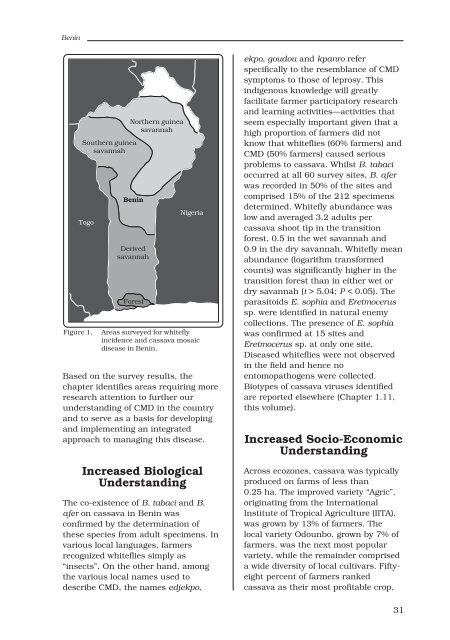Whitefly and whitefly-borne viruses in the tropics : Building a ... - cgiar
Whitefly and whitefly-borne viruses in the tropics : Building a ... - cgiar
Whitefly and whitefly-borne viruses in the tropics : Building a ... - cgiar
Create successful ePaper yourself
Turn your PDF publications into a flip-book with our unique Google optimized e-Paper software.
Ben<strong>in</strong><br />
Nor<strong>the</strong>rn gu<strong>in</strong>ea<br />
savannah<br />
Sou<strong>the</strong>rn gu<strong>in</strong>ea<br />
savannah<br />
Togo<br />
Ben<strong>in</strong><br />
Derived<br />
savannah<br />
Forest<br />
Nigeria<br />
Figure 1. Areas surveyed for <strong>whitefly</strong><br />
<strong>in</strong>cidence <strong>and</strong> cassava mosaic<br />
disease <strong>in</strong> Ben<strong>in</strong>.<br />
Based on <strong>the</strong> survey results, <strong>the</strong><br />
chapter identifies areas requir<strong>in</strong>g more<br />
research attention to fur<strong>the</strong>r our<br />
underst<strong>and</strong><strong>in</strong>g of CMD <strong>in</strong> <strong>the</strong> country<br />
<strong>and</strong> to serve as a basis for develop<strong>in</strong>g<br />
<strong>and</strong> implement<strong>in</strong>g an <strong>in</strong>tegrated<br />
approach to manag<strong>in</strong>g this disease.<br />
Increased Biological<br />
Underst<strong>and</strong><strong>in</strong>g<br />
The co-existence of B. tabaci <strong>and</strong> B.<br />
afer on cassava <strong>in</strong> Ben<strong>in</strong> was<br />
confirmed by <strong>the</strong> determ<strong>in</strong>ation of<br />
<strong>the</strong>se species from adult specimens. In<br />
various local languages, farmers<br />
recognized whiteflies simply as<br />
“<strong>in</strong>sects”. On <strong>the</strong> o<strong>the</strong>r h<strong>and</strong>, among<br />
<strong>the</strong> various local names used to<br />
describe CMD, <strong>the</strong> names edjekpo,<br />
ekpo, goudou <strong>and</strong> kpanro refer<br />
specifically to <strong>the</strong> resemblance of CMD<br />
symptoms to those of leprosy. This<br />
<strong>in</strong>digenous knowledge will greatly<br />
facilitate farmer participatory research<br />
<strong>and</strong> learn<strong>in</strong>g activities—activities that<br />
seem especially important given that a<br />
high proportion of farmers did not<br />
know that whiteflies (60% farmers) <strong>and</strong><br />
CMD (50% farmers) caused serious<br />
problems to cassava. Whilst B. tabaci<br />
occurred at all 60 survey sites, B. afer<br />
was recorded <strong>in</strong> 50% of <strong>the</strong> sites <strong>and</strong><br />
comprised 15% of <strong>the</strong> 212 specimens<br />
determ<strong>in</strong>ed. <strong>Whitefly</strong> abundance was<br />
low <strong>and</strong> averaged 3.2 adults per<br />
cassava shoot tip <strong>in</strong> <strong>the</strong> transition<br />
forest, 0.5 <strong>in</strong> <strong>the</strong> wet savannah <strong>and</strong><br />
0.9 <strong>in</strong> <strong>the</strong> dry savannah. <strong>Whitefly</strong> mean<br />
abundance (logarithm transformed<br />
counts) was significantly higher <strong>in</strong> <strong>the</strong><br />
transition forest than <strong>in</strong> ei<strong>the</strong>r wet or<br />
dry savannah (t > 5.04; P < 0.05). The<br />
parasitoids E. sophia <strong>and</strong> Eretmocerus<br />
sp. were identified <strong>in</strong> natural enemy<br />
collections. The presence of E. sophia<br />
was confirmed at 15 sites <strong>and</strong><br />
Eretmocerus sp. at only one site.<br />
Diseased whiteflies were not observed<br />
<strong>in</strong> <strong>the</strong> field <strong>and</strong> hence no<br />
entomopathogens were collected.<br />
Biotypes of cassava <strong>viruses</strong> identified<br />
are reported elsewhere (Chapter 1.11,<br />
this volume).<br />
Increased Socio-Economic<br />
Underst<strong>and</strong><strong>in</strong>g<br />
Across ecozones, cassava was typically<br />
produced on farms of less than<br />
0.25 ha. The improved variety “Agric”,<br />
orig<strong>in</strong>at<strong>in</strong>g from <strong>the</strong> International<br />
Institute of Tropical Agriculture (IITA),<br />
was grown by 13% of farmers. The<br />
local variety Odounbo, grown by 7% of<br />
farmers, was <strong>the</strong> next most popular<br />
variety, while <strong>the</strong> rema<strong>in</strong>der comprised<br />
a wide diversity of local cultivars. Fiftyeight<br />
percent of farmers ranked<br />
cassava as <strong>the</strong>ir most profitable crop,<br />
31
















